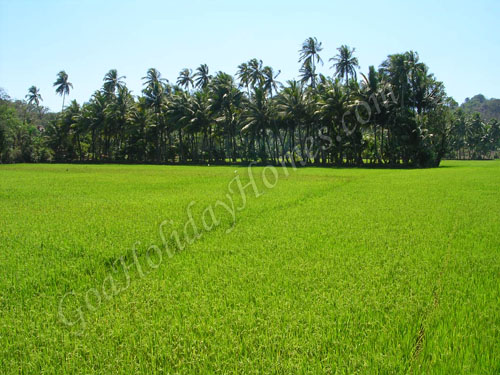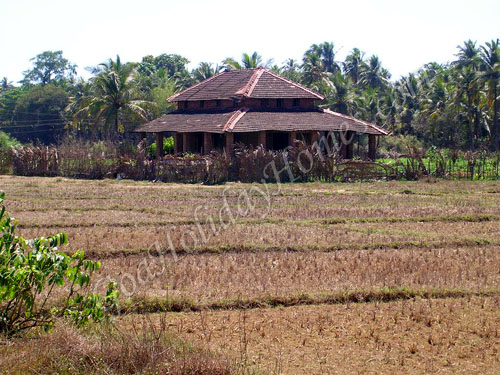Iconography of Goa
There are two dominant views about the spread of Christianity in Goa. One view is that the evangelists - a wide assortment of them in terms of their nationalities and religious affiliations - achieved their results because they were severe. The other view, a trifle simplistic, is that the evangelists were catalysts of great and continuing miracle.
Pietro Della Valle who visited Goa around 1624, the year when St. Francis Xavier who was canonized, describes scenes in his memoirs which were strange in his view, There is no country in the world where so many possessions are held as in Goa.
Another European travelers, an unlikely purists, Gabriel Dellon, had seen in Old Goa a sick Portuguese youth who had an ivory image of the Virgin in his bed 'which he reverenced much and often kissed and addressed himself to it'.
The Indian elements of Goan iconography and other Christian works of art have been identified over the years ; Indian Fauna (like Madonna on crocodile) and floral elements (Like a Modonna holding a flower) a tendency to stylize, introduction of Indian celestial symbols (like moon phases), oval faces and a certain partisanship for colours like bright red, blue and green.
Indian influence in 'religious art' - which is acknowledged by contemporary Portuguese art critics and historians, like Prof. Reynaldo dos Santos and Carlos de Azevedo as 'elements of pagan culture' - is to be found at its best in the silver casket of St. Francis Xavier which was exclusively done by Goan jewellers.
Goa - Location
Situated on the western coast of the Indian Peninsula, the state is separated from Mahrashtra by the North, Karnataka in the South, the Western Ghats in the East, and the Arabian Sea in the West.
The "Western Ghats" mountain's impenetrable, dense rainforests that make up Goa's eastern border have been labeled as one of the richest ecosystems of the plant and bird species by the National Geographic magazine and are among the two biodiversity hotspots in India.
Goa - Physical Features
Goa as a region can be divided into four divisions - the Eastern Hill region comprising areas in the Sattari, Ponda, Canacona, and Sanquem, the Central Valley Lands comprising Pernem, Bicholim, Sanguem and Quepem, the Flood Plains comprising the coastal plains and rolling uplands and the areas of Tiswadi, Mormugao, Bardez and Salcete.
There are several rivers and streams that flow through the state. The major ones Tiracol, Talpona, Galgibagh and Chapora are navigable and are of immense economic importance as ores are transported through these rivers for export.. Some of the famous lakes are the Mayem Lake and the Carambolim Lake.
Goa - Climate
Temperature in Goa is moderate with not much variation. The summer is at its hottest in May while January and February are the coldest. Otherwise, the state experiences tropical weather, it rains between the months of June to September.
Goa - Flora and Fauna
About a third of Goa's total land area is still covered by forests. When the first wildlife reserves had hardly any animals in them. The Bhagwan National Park near Molem is the largest reserves with large numbers of leopards and several spices of birds.
Goa - Ethnicity
Despite being under Portuguese control for so long, majority of the people in Goa are still Hindus. The influences are everywhere in the art, culture and society. The demography of the state started coming of the Portuguese in the 15th century due to the spirit of propagating Catholicism. The minority of Muslims community that is found in this state is the result of the brief period in the early Muslim rulers reigned over the state.
Goa - Art and Crafts
The art and craft forms of Goa show a remarkable harmony between Portuguese and Indian culture state are intricately beautiful, capturing the fancies of tourists and locals alike. These crafts can be a mirror of Goa's perennial glory and beauty and they have carved a niche for themselves with the world over. The major art forms of the state include bamboo craft, woodcarving, brass metals and wooden lacquer ware. Other important crafts of the state include jute macramé, crochet and embroidery, fiber and batik prints, fiber stone carving, coconut shell carving and imitation jewelry, cotton dolls, soft toys, woolen tapestry and artistic weaving.
Goa - Music and Dance
In Goa, almost any time is party time! Song and dance seem to run in the blood of Goans, dancing and revelry are an integral part of Goa weddings, which combine Catholic and Indian traditions. The occasions to lapse into celebration are many, the feast day of the patron saint (and every village has one) is a major celebration, for which the whole village turns out.
At the end of the day's work and before the evening meal, it is a common practice for the young and old to join together in singing devotional songs. Even in the times between feasts one can easily come across young Goans in the evenings singing a Mando (traditions love song) to a quiet guitar. Or in the predawn hours, the robust singing of fisher fold setting out to sea. Dances of the State include Bhandad, Corredinho, that are Portuguese folk dances, Fugdi and Dhalo, Ghode Modnti, Kala and Dashavatar Lamp Dance etc and others.
Goa - Attire
Unlike most other parts of India, Goa has a distinct style in every sphere of life. A popular sight is that of skirts on the roads, due to strong Portuguese influences. Traditional clothing also has its importance in this place women wearing the sari in a style that is quite different from any other places in India.
Goa - Cuisine
The Goan cuisine is an interesting mix of varied influences, there are points where they produce culinary wonders. The ever popular pork vindaloo is a result of combination, it is a gourmet's paradise. The coast line is a rich trove of seafood. Delectable prawns, oysters, lobsters, crabs, squids, mussels, pomfret - the specialties abound. Each imbued
With the inimitable flavors of Goan cooking - the inspired use of spices, the snap of chillies, and a truly formidable variety of curries. These flavors lend themselves to the exotic meat and chicken dishes of the land, sorpotel, chicken cafrial and xacuti and the succulent goa sausages.
For Vegetarians there is the delicious Konkani cuisine, as well as a multitude of South Indian restaurants that dot the towns of Goa.
Feni is Goa's famous contribution to the world, the drink prepared from cashew apples. Feni is brewed in many a house. Other alcoholic drinks are cheaper in Goa than other states in India.
Shopping
All beach towns have several shops selling souvenirs and handicrafts from all over the country. Goa's varied handicrafts include decorative items made from sea-shells, palm leaves and earthernware pottery. Goa Handicrafts Rural and Small-Scale Industries Development Corporation helps in the marketing of the Local produce through their emporia. Goa has hundreds of shops selling everything from leather garments to Tibetan jewellery from gems to fur coats. Supermarkets sell packets of readymade babinca, as well as pounches of ready to use powdered masalas for reichado xacuti and cafrial.
Contact Details
Address: Angela Marquis, UAE


